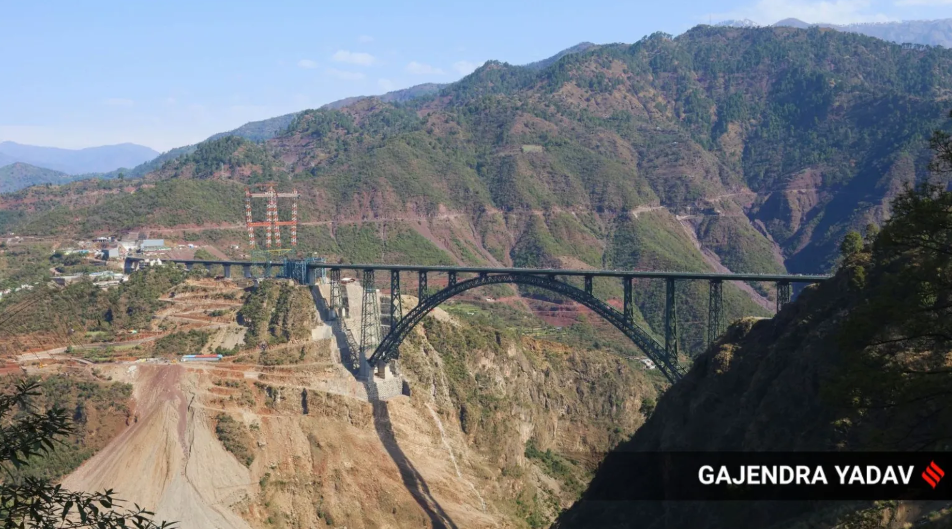Description

Disclaimer: Copyright infringement not intended.
Context
Prime Minister Narendra Modi recently inaugurated the Banihal-Sangaldan section of the railway line which aims to connect Baramulla in North Kashmir to Udhampur in Jammu.
Details
The Banihal-Sangaldan railway line
- More than 90 per cent of the 48-km railway line between Banihal to Sangaldan passes through tunnels in the mountainous Ramban district, including the country’s longest77-km tunnel (T-50).
- It also has 16 bridges. For the safety and rescue of passengers in emergencies, it has three escape tunnels with a combined length of 30.1 km. It has been built at a cost of Rs 15,863 crore.
Why it is important
Travel option to Valley when roads not usable
- With the train reaching Sangaldan, people now have a way to travel between Jammu and Kashmir even when the National Highway-44 is closed for vehicular traffic between Ramban and Banihal due to landslides.
- One can travel 30-35 km to Sangaldan by road from Ramban town and then board the train to Kashmir.
Promote tourism and economy
- The train route also opens far-off areas of Jammu division for tourists, and thus for more economic activity.
- Hot water springs are situated nearly 5 km from Sangaldan and the picturesque Gool Valley is nearby. These areas have largely remained unexplored so far for want of better road connectivity.
Valley still away from Indian railways network
- It will take a few more months for the Valley’s truncated rail line to connect with the Indian Railways network across the country. Of the total 272-km-long Udhampur-Srinagar-Baramulla railway line, nearly 209 km has been commissioned so far. The Valley is likely to be connected with the Indian railways network by May this year.
- A stretch of nearly 63 km, on which works are nearing completion, falls in Reasi district. This stretch has the world’s highest single arch railway bridge standing at a height of 1178 mts above the Chenab riverbed, surpassing the Eiffel Tower of Paris by 35 meters.

History of railways in Jammu and Kashmir
- The first railway line in the former princely state of Jammu and Kashmir was built by the British in 1897 over a distance of 40-45 km between Jammu and Sialkot in the plains.
- In 1902 and 1905, a railway line was proposed between Rawalpindi and Srinagar along the course of the Jhelum, which would have connected the Kashmir Valley with the railway network of undivided India. But Maharaja Pratap Singh of Jammu and Kashmir was in favour of a Jammu-Srinagar line via Reasi, and neither project progressed.
- After Partition, Sialkot went to Pakistan, and Jammu was disconnected from the rail network of India. Until the inauguration of the Pathankot-Jammu line in 1975, the railway station nearest to Jammu and Kashmir was Pathankot in Punjab.
- In 1983, work began on a railway line between Jammu and Udhampur. The 53-km line, estimated to cost Rs 50 crore, was supposed to be completed in five years, but ultimately took 21 years and Rs 515 crore. The project, which was completed in 2004, has 20 major tunnels, the longest of which is 2.5 km long, and 158 bridges, the highest of which is 77 m high.
- With work underway on the Jammu-Udhampur line, the Centre in 1994 announced the extension of the line from Udhampur to Srinagar, and then Baramulla. This was the Udhampur-Srinagar-Baramulla Railwayline (USBRL) project, which was approved in March 1995 at an estimated cost of Rs 2,500 crore.
- The project got momentum after 2002, when Prime Minister Atal Bihari Vajpayee declared it a national project on account of its being among the most challenging works undertaken by the Indian Railways after Independence. The project cost has now ballooned to more than Rs 35,000 crore.
- The line will connect Srinagar and Baramulla in the Valley with the rest of the country by train, and will provide a reliable and cost-effective all-weather alternative to the Jammu-Srinagar national highway that is frequently shut down due to landslides
Challenges and innovations
- The Himalayas are young, and the geologically unstable Shivalik Hills and Pir Panjal mountains lie in the seismically most active Zones IV and V. The terrain is difficult and sees heavy snow in winter, and presented serious challenges in the construction of bridges and tunnels.
- More than 205 km of motorable roads — including a tunnel and 320 bridges — were built at a cost of Rs 2,000 crore to transport heavy machinery, construction material, and workers to construction sites, many of which were on sheer mountain faces at inclines of 70 degrees or more.
- In view of the challenges in the construction of highly complex tunnels and huge bridges in unstable mountainous terrain, Railways engineers devised a novel Himalayan Tunneling Method (HTM), in which horseshoe-shaped tunnels were constructed instead of the usual D-shaped ones. In this method, the site comes down in a curve, giving strength to the structure where the soil above it is loose.

Benefits
- The train will bring down the travel time between Srinagar and Jammu to between three and three-and-a-half hours from the five to six hours that it takes by road currently.
- According to Railway Ministry, Vande Bharat trains will allow people to travel from Jammu to Srinagar and return that same evening.
- The train will benefit the people of Kashmir by facilitating hassle-free transport of goods such as apples, dry fruits, pashmina shawls, handicrafts etc., to other parts of the country in the shortest possible time and at lesser cost.
- The cost of transporting items of daily use to the Valley from elsewhere in the country is also expected to go down significantly.
- Four cargo terminals will be built between Banihal and Baramulla; land has been identified for three of these.
|
PRACTICE QUESTIONS
Discuss how monetisation of railway assets plays a significant role in resolving various issues of the Indian railways. (250 Words)
|











